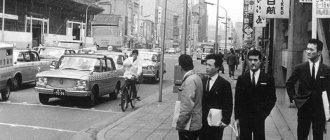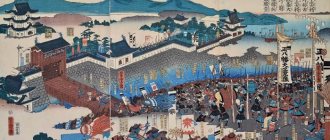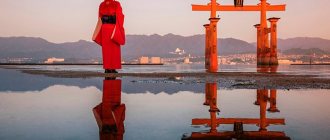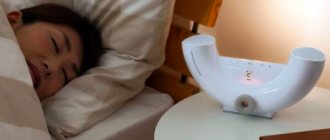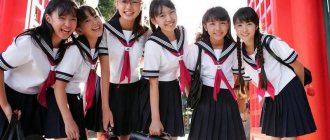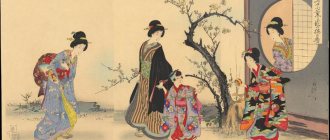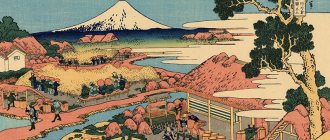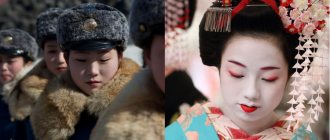Kimono for the Hina Matsuri holiday
This outfit in a traditional Japanese style is intended for very little fashionistas of the Land of the Rising Sun: one-year-old girls are offered to dress one-year-old girls in such soft pink silk kimonos.
This kind of clothing is bought at least once a year, before the Hina Matsuri holiday. This is a doll festival and is celebrated annually on the third day of the third month. The meaning of the holiday, which dates back to the Heian era - 8-12 centuries. - is to express my respect to all the girls living in the house.
© global.rakuten.com
A set of festive clothes for girls consists of a matching kimono, a long skirt and a head decoration that is attached with an elastic band.
On this day, noble families invited special snake charmers: they performed a complex ritual, after which it was believed that all troubles and bad weather would be transferred to paper dolls, which were made specifically for this purpose.
These dolls - nagashi-bina - were displayed on a special shelf located in the central room of the house. The dolls were then symbolically floated down the river. Today they look like a real work of art.
Lesson “Japan - the land of the rising sun” for the project “There are many of us on the globe”
Goal: to introduce children to the new Japanese culture; talk about the flora and fauna of the country; develop an interest in Japanese heraldry; cultivate tolerance.
Equipment: video equipment, video materials; doll in kimono; blank images of people in kimonos, felt-tip pens, gel pens, paints.
Progress of the lesson
(The teacher’s story is accompanied by a video showing.)
Educator: Japan is an island state, that is, it is located on islands washed by the seas and oceans, in the very east, where the sun rises into the sky every day. In Japan, the first thing people see in the morning is the rising sun. That’s why they say: “Japan is the land of the rising sun.” The Japanese flag also features the sun (red circle) in a clear sky (white background). The nature of the country is different from the nature of Russia. The vegetation is not so rich and varied, since mountains take up a lot of space. Favorite tree is sakura. The national pride of the Japanese in the animal world is the white and black bear - the panda. There are many small and large cities in Japan. The most important city in the country is its capital, Tokyo. The population of Japan is called the Japanese. Outwardly, the people of this country are a little different from you and me. They have a different skin color and eye shape, dark hair and speak a different language - Japanese.
The Japanese are very friendly, polite and helpful. But at the same time, handshakes at a meeting, like ours, are not accepted among them. They are replaced by bows. In Japan, they treat old people and children with great respect. They are loved and cared for. Japanese children, just like you, attend kindergartens, but they are there for a very short time - only 2 - 3 hours a day. Such kindergartens are called ETIEN. Here classes are held on their development and aesthetic education, they are taught to “be friends” and be polite. Mothers are often present with their children in kindergarten and participate in their games and walks. Favorite outdoor game “Panda and Children” (something like our “tag”) I suggest you play it now.
Outdoor game "Panda and children." (“The panda is sleeping, and the children are trying to wake it up. Having woken up, the panda catches the children.”)
The people of Japan now dress in European style clothes. And there was a time when both men and women wore national clothes - kimono (looking at a doll in a woman's kimono, watching videos). I would like to note that all the clothes are very bright, there is a lot of embroidery with gold threads. Firebirds, dragons and other fairy-tale characters are often depicted on clothes. Japanese women applied a thick layer of rice powder to their faces. It was believed that the whiter the face, the more beautiful. Eyes and lips were also brightly painted with special paints. The shoes were made of wood and a leather strap and were called clogs. Women's clogs were on a high platform. Walking in such shoes was very uncomfortable and difficult. Therefore, the Japanese women moved in small, quick steps.
Now Japan is considered one of the most developed countries. All the most modern electronics are created in Japan (watch video materials).
That's how much you've learned about Japan. And now I suggest you decorate a woman’s kimono. Your tables have everything you need for this.
Finger gymnastics “Friendship”.
Children's work using mixed media (paints, felt-tip pens, gel pens for drawing details).
Exhibition of children's works.
Hair ornaments
© global.rakuten.com
This accessory is quite expensive, and you are unlikely to see it in everyday life. Why? If we draw an analogy with Russian culture and judging by the price, it’s the same as buying your daughter a kokoshnik embroidered with, say, pearls and gold threads. And, by the way, this idea may not be so absurd. Loyalty to traditions often means caring for one’s roots and parents.
Popular message topics
- The work of Oleg Efremov
Speaking about Ivan Antonovich Efremov, it should be said that this man had absolutely encyclopedic knowledge and from this point of view he was the successor of that series of outstanding - Chemistry in human life
How many schoolchildren sit until the morning reading chemistry textbooks, swearing at the whole world and not understanding why they need it. But once they understand how closely their lives are connected with this field of science, their interest awakens. - Wood mouse
There are many species of rodents around the world, including about 100 species of mice. The most common of them are field, forest and house mice. They are all very similar, but still have differences. This report
Hello Kitty sound blocker
© japantrendshop.com
This Hello Kitty keychain is very functional. It is designed to protect its shy owner from unwanted intrusion into personal space. For example, when using a public toilet. Whenever a girl or boy needs to relieve themselves, the keychain automatically turns on, filling the room with the sound of pouring water, so that all other natural sounds in such a situation will not be heard by others.
Microphone that can only be heard by the owner
Any of us has found ourselves in a situation where singing turned out to be inappropriate and out of place - be it a walk around the city or morning chants in the shower. Let's add the completely understandable desire of any mother to sometimes shout loudly - so as not to say loud and offensive words to her precious household members, even if they are well deserved.
© mikeshouts.com
The Utaet Voice Training Silent Karaoke microphone, invented in Japan, is incredibly popular in the country - no one's ears, even the most sensitive, are harmed when using it. You can sing at the top of your lungs - or shout or make any sounds in general, and those around you will relieve you of their criticism. Another obvious advantage is that you can hear what your own voice sounds like in its natural form. Many people find it so useful that they begin to study vocals with teachers. Or they stop tormenting the microphone altogether.
Online lesson on the world around us “Peoples and countries. Japan"
Today, in an Internet lesson on the world around us, we will take a virtual trip to Japan...Japan is an island state. It occupies four large islands - Hokkaido, Honshu, Kyushu and Shikoku and about 900 small islands.
Japan flag
Coat of arms of Japan
Japan is ruled not by a president, but by an emperor.
In terms of population, Japan ranks 6th in the world. Japan has 8 major cities with populations exceeding 1 million people. This is primarily the capital of the country, one of the largest cities in the world - Tokyo.
You can take a stroll through the cities of Japan here.
Language - Japanese, currency - yen
The letter consists of semantic hieroglyphs
Due to poor natural resources, the Japanese have learned to save money. The work is based on waste-free production. Japan is a kind of giant workshop for processing industrial raw materials and producing finished products. Agriculture and fishing are very well developed. Fish, various crustaceans, algae and other seafood occupy an important place in the Japanese diet.
Cities have excellent transportation systems. Urban residents of Japan take pride in their extensive rail system, which includes subways and skytrains.
Many public places where there are a lot of people are quite quiet. Believe it or not, each of them is lost in their own thoughts, this is the so-called “meditation on the go”, and they do not like it when something or someone disturbs the silence. Many Japanese practice traditional martial arts such as judo or kendo.
Although Japan is a modern, developed country, ancient culture is highly respected here. They treat ancient temples with respect.
Ancient five-story castle Osaka Castle
Also from Japan came to us: origami, ikebana, kimono, lyrical poetry - haiku:
“caution sometimes forces one to remain silent”
“They scare them, drive them out of the fields! The sparrows will fly up and hide under the protection of the tea bushes...
The Japanese are hardworking, but also love to have fun. Japan has many holidays and annual festivals. Of course, Japan's favorite holiday is New Year, where they bake a traditional treat - rice cakes. On February 22, the Japanese celebrate Cat Day. The fact is that the word “two” in Japanese sounds “ni”, and is playfully pronounced “nan”. Coincidentally or not, the Japanese believe that a cat meows as “nyan-nyan-nyan”. That is, “Nyan-nan-nan” is “two-two-two”, and “two-two-two”, respectively, is the twenty-second day of the second month, that is, February 22. The kindest and most joyful festivals in the world can be called the Sapporo Snow Festival or the Sapporo Snow Figure Festival
On November 15, Japan celebrates everyone's favorite ancient Japanese holiday, Shichi-Go-San. The translation of the name is incredibly simple: City is seven, Go is five, San is three. This children's holiday, whose history goes back more than 300 years, can be called the common birthday of all children who turned 3, 5 or 7 years old this year. Since ancient times, these odd numbers have been considered magical in Japan, and the ages corresponding to them reflected important, turning points in the growing up of children. It is impossible not to say, probably, about the main spring event in Japan - cherry blossoms. The Japanese call sakura viewing o-hanami (March 26). The flowering period is relatively short, so cherry blossoms are admired both during the day and in the evening.
March 3 is Girls' Day.
What other attractions of Japan are known throughout the world? This is Mount Fuji. A famous and incredibly beautiful volcano, to which many poems by Japanese poets and many paintings by Japanese artists are dedicated.
Okinawa Island is Japan's main seaside resort. Its main natural resources are corals of all colors, the rarest black pearls, mined only here.
Japan is famous for its new technologies. Some are described on our website here.
The Smart Fridge smart refrigerator can offer users recipes based on what products are in it. True, each of the products must be entered into the database by writing its name on the display, which is the refrigerator door. Then you just need to go to the main menu on the door, select one of the proposed recipes and obediently follow the step-by-step instructions, which the refrigerator will cheerfully announce to the entire kitchen.
That's all for today. See you on the next virtual journey...
I recommend reading:
- 77 Effective Educational Techniques
- Our achievements, our TALENTS!
- Interesting...Great people who changed the world
- Learning to read... 2000 simple tasks
Tags: videointerestingInternet lesson the world around us
Sleeping device Сheero sleeping
Insomnia is a real scourge of our time; both adults and, unfortunately, even children are susceptible to it. If the baby is too active and does not want to go into the arms of Morpheus, it is worth turning on this Japanese “sleep aid” for him - if, of course, you can find it outside the country of origin.
© digitaltrends.com
The device, laconic in shape, will fit into any interior. This is also a night light - it emits a soft and pleasant light, reminiscent of the Moon or candles, and produces soothing sounds that induce sleep. It is also a fragrance - as a result, the air becomes fresh and the atmosphere becomes soothing. The device is popular in the Land of the Rising Sun, but is practically unknown in other countries.
Brief story about Japan
Everything about Japan.
Japan is a country located on islands, most of which are of volcanic origin. The largest are Hokkaido, Honshu, Shikoku, Kyushu. Most cities are concentrated on them. Japan is located in East Asia. It is surrounded by China, Taiwan, North and South Korea, and Russia. The archipelago is washed by the Sea of Okhotsk, East China and Japan. The highest point of the Japanese archipelago is Mount Fuji, which often becomes the subject of poetry.
1.Name.
The word “Japan” came to us from the German language. The country is actually called Nihon Koku. This name is official. It is used on money, documents and postage stamps. There is another option - Nippon koku. It is most often heard in spoken language. The word "nihon" is translated as "source of the sun." Hence the popular name Land of the Rising Sun.
2.Management.
In Japan, both parliament and constitution operate simultaneously, but at the same time, part of the power belongs to the emperor.
It is considered a symbol of the country's unity. The history of the imperial family originates from mythology. According to ancient legends, the first emperor was of divine origin. Parliament consists of 480
deputies who are elected for a term of
4
years and are called the House of Representatives.
The House of Councilors consists of only 242
seats, the electoral term of which
6
years.
Universal suffrage applies to all residents of Japan over 20
years of age. Representatives are selected by secret ballot. There are two parties in Japan - the social liberal Democratic Party and the conservative Liberal Democratic Party. The executive branch is headed by the Prime Minister of Japan, who is chosen by the Emperor. He forms the composition of the government. The court in Japan consists of four levels. The highest of them is the Supreme Court. He can repeal legal provisions that are contrary to the constitution. Representatives of this court are appointed by the emperor, while all others are appointed by the Cabinet of Ministers. The appellate courts are the highest courts, followed by the district courts, which play the role of the rest. The simplest disciplinary courts.
3. General.
Japan is a country that has always been difficult for many foreigners to understand. Her amazing legacy excites many. The traditions are very different from the European ones we are used to. This is often what catches your eye when you first visit a country. The people there are extremely friendly, they always want to see a smile on the face of others. The Japanese are open and at the same time value personal space. You can't get too close to them, you need to keep your distance. Many people are familiar with Japanese traditions and society. Anime, action figures and cosplay are very popular these days. Gradually, ancient culture and mythology begins to penetrate into other countries, which makes it much clearer and easier for representatives of other nations. Anime is one of the animation genres that has become extremely popular. He captivates many with his unusualness. It can be said that people find charm in a new form. Manga has also become very popular - hand-drawn comics that are read from left to right.
A short story about Japan (option 2)
A short story about Japan (option 3)
Robot pets
© serty.ru
In recent decades, it has become too expensive and troublesome to have a pet - apartments in Japan are small, but taxes are high. Therefore, for many Japanese it is easier and more profitable to get an electronic puppy or kitten. There are quite a few varieties of such “little animals”. Starting with the famous Tamagotchi, which needs to be fed and petted exactly as if alive, and ending with devices on wheels that can move around the house, approach their owners, purr or purr and wag their tail.
- share with your friends!
Japan Post Report
In the 1st century BC. Until the 3rd, the Japanese tribes gradually began to unite together. The Yamato tribe, the 1st dynasty of emperors, took supremacy over the tribes.
Until 710, there was no permanent capital in Japan due to the fact that each subsequent emperor, along with his retinue, moved to a new place according to Shinto customs - it was impossible to live where the previous emperor was buried. In 710, the capital of Heijō-kyō was established. In the 9th century, Japan stopped all contact with China (China had previously been the standard for the life of the Japanese), which gave it impetus for independent development in all spheres of life (from home life to religion).
In the 12th century, dual power was established - the emperor controlled external traditions, but the basic right to govern the country remained in the hands of the military (shoguns).
In 1274, after conquering China, the Mongols decided to seize Japanese lands. They almost managed to do this, but a typhoon that covered the coast of the islands smashed their fleet into pieces. In 1281, a second attempt by the Mongols to capture Japan also failed - a typhoon again destroyed their fleet.
Muromachi period
In 1333 there was a division of power. The incumbent Emperor Godaigo escapes the capital of Kyoto and establishes a new capital in Yoshino, creating the Southern Court. At this time, Shogun Ashikaga becomes emperor in Kyoto and establishes the Northern Court. From that moment on, 2 emperors tried to rule the country. However, due to constant wars between other military clans, both Ashigaka and subsequent emperors from his clan did not have full power. As a result, in 1447 the Ashigaka clan was overthrown and the capital Kyoto was destroyed. Having lost their center of power, each military clan began to impose its own rules on its subject territories. From that moment on, the feudal fragmentation of the country began, which lasted 100 years.
Europeans began to establish contact with Japan - the first firearms were imported, and an attempt was made by missionaries to convert the Japanese to Christianity.
Azuchi-Momoyama period
In 1573, the last shogun of the Ashikaga clan was expelled. The period of feudal fragmentation was over, and from that moment on, under the leadership of Oda Nabunaga, the unification of the lands began. After the death of Nabunaga, the unification of lands was continued by Toyotomi Hideyoshi. He banned monks and peasants from having weapons, forced samurai to become city dwellers, conducted the first census, and banned Christianity. He tried to conquer Korea and China, but suddenly died and the military campaign against these countries automatically stopped. Until the 20th century, Japan did not attack other states in its first war.
Edo period
In 1603, shogun Tokugawa Ieyasu came to power and completed the unification of the clans into a single country. He created a 5-class system, according to which the population was divided into samurai, artisans, merchants, peasants and eta. This one is the Japanese who did the most obscene and humiliating work. Under Tokugawa rule, a period of calm and peace began. The revolt that the peasants tried to raise under the slogans of Christianity was quickly suppressed. From that moment on, a decree was signed that prohibited Europeans from entering Japanese lands. The country's voluntary self-isolation has begun. But in 1853, the American officer Parry forced the Japanese to open the way for trade. The dissatisfaction of the country's residents with self-isolation and many other problems led to the shogun being overthrown from the throne, and power passed into the hands of the emperor.
Meiji period
The new emperor makes the city of Tokyo the main city of Japan. An intensive transformation of the country began: class inequality was abolished, freedom of religion was declared, and compulsory primary education was introduced. The country has completely opened its doors to foreigners - student exchanges have begun. In 1889, the country's first Constitution was adopted.
A war began with Russia, where it eventually wins and expands its territorial borders. Annexes Korea.
World War 2
In 1937, the Sino-Japanese War began. It ended in 1945 with the defeat of Japan. Immediately after the war, the United States carried out its first nuclear weapons attack on humans, dropping bombs on Hirashima and Nagasaki. The country was in distress. The United States took advantage of this and carried out reforms in Japan: a new Constitution was adopted, which abolished the country's armed forces.
In 1952, Japan, according to the Peace Treaty, freed itself from US occupation and began to restore ties with the Soviet Union and China. The country's economy began to boom.
2nd, 3rd, 4th grade, the world around us, briefly
